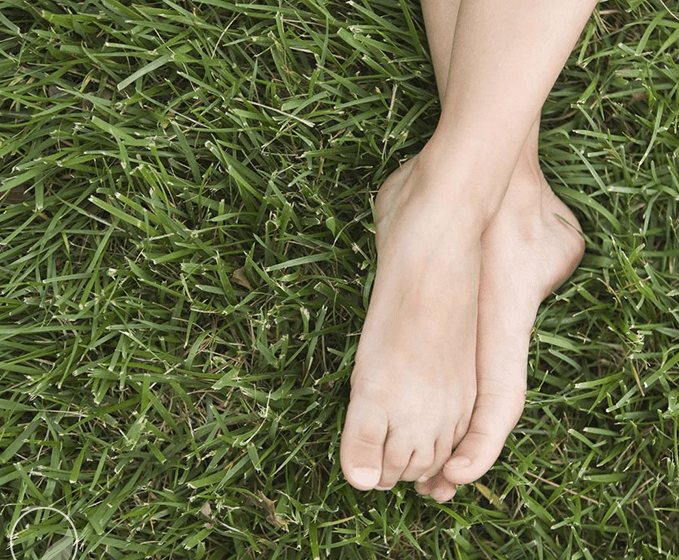
So you have learned all about the benefits of earthing but can’t really commit to purchasing a grounding mat. Earthing mats, grounding sheets – whatever you want to call them – can be a bit expensive. Most experienced users will tell you that they are worth the money but a beginner, or someone who just wants to check it out, might want to consider making one.
For full disclosure – you could actually avoid the whole mess by walking around outside barefoot and sleeping on the ground. But that isn’t really practical for most people – not to mention uncomfortable or even painful for those of us who don’t really want to sleep outside with the bugs, on the hard (I repeat hard) ground.

Never fear – there is a solution with a bit of planning and a few easily acquired items. If you have someone who is technically inclined, you might want to have them help you but it isn’t a necessity.
There are several ways to make a home-made device for grounding – you will get all of the benefits without the cost – but have to put in a bit of work.
Method #1: Cheap and Easy
You can actually use a grounding rod directly connected to the Earth. You will need:
- A copper rod or pipe purchased from a plumbing supply or hardware store (Pure copper)
- Copper coupling device
- 18 gauge or lower (16, 14, etc.) Copper wiring – 20 feet or so
- Window that can be left slightly open or a hole drilled through the wall
To assemble:
- Hammer the rod or pipe directly into the ground outside of your window.
- Tie a piece of the wire long enough to reach through your window or through a hole in the wall to the rod. You will have to strip the insulation from both ends of the wire.
- Run the wire through the window or hole that you have drilled into the house.
- Flatten the copper coupling by pounding with a hammer until almost flat
- Insert the stripped wire end into the coupling and continue pounding until the coupling is flat and has grabbed onto the wire.
- Drop the coupling into your sock (preferably at the ball of your foot) or hold it against your wrist with a piece of fabric, a tennis wristband or a sock top.
In dry climates, or if it has not rained recently, you should “water” the pipe or rod stuck into the ground to increase the flow of positive electrons – or the grounding effect.
If you live in a house with metal water pipes you can also use the plumbing as the “grounder” rather than a copper rod in the ground, which may be considerably more convenient. It will not work on PVC or plastic pipe.
Method #2: Also Cheap but Requires a Little Electrical Knowledge
You will need:
- Grounded Plug end (available at hardware or electrical supply store)
- A 10K ohm (1/2 watt) resistor from an electronics or electrical supply store DO NOT OMIT THIS PART
- 12 inches of electrical wire
- 10 feet of electrical wire
- Electrical tape or wire nuts (or both)
- Copper coupling
- Outlet checker (available at any hardware store)
- Circuit checker (available at hardware, electrical or electronics supply)
To assemble:
- Attach one end (stripped) of short wire to ground terminal on electrical plug.
- Attach other end (stripped) of short wire to 100 K ohm resistor, using lots of electrical tape or wire nut
- Attach one end of long wire (stripped) to other end of 100 K ohm resistor, using electrical tape or wire nut
- Flatten copper coupling onto free, stripped end of long wire, pounding with hammer until flattened and wire is held securely in coupling.
- Test the outlet you plan to use with grounding checker before plugging earthing device in.
- Test the circuit for proper grounding by plugging the device into the bottom outlet plug. Insert one probe into small slot of top outlet, touch the other end to flattened coupling. If the tester lights up, the system is working.
- Once finished, plug device into outlet and drop coupling into sock or attach to wrist as above.
This method does not transmit electricity from the wall – but drains positive charge from you. If you are squeamish, have your electrically minded friend check it out for you.
DO NOT OMIT THE RESISTOR and DO NOT USE in an electrical storm.
Method #3: More Convenient, but More Complex and May Need Periodic Repair
You will need:
- Aluminum tape (available at hardware store)
- Bath towel
- 100 K ohm resistor
- 12 inches of electrical wire
- 10 feet of electrical wire
- Electrical tape or wire nuts (or both)
- Outlet checker (available at any hardware store)
- Circuit checker (available at hardware, electrical or electronics supply)
To assemble:
- Cut 15 to 20 aluminum tape into strips that are nearly as wide as towel.
- Place about 2 inches apart onto towel or blanket horizontally (like ladder rungs).
- Cut 2 strips of aluminum tape that are as long as the towel
- Carefully remove aluminum tape backing from one long strip, folding strip slightly on long end so that it sticks to itself but still has plenty of “stick” to attach to towel. Stick strip along edges of “ladder rungs”.
- Repeat with second strip. You should now have a towel with an aluminum tape “ladder” on one side.
- (the folding of the tape is necessary because the aluminum on the “rungs” must be in contact with the aluminum on the ladder “sides” to allow energy flow)
- Lay one stripped end of the long wire on one corner of the aluminum ladder on the towel in a “J” or “O” shape. Secure with electrical or aluminum tape.
- Attach opposite end of wire (stripped) to 100 K ohm resistor using wire nut or electrical tape.
- Attach one end of short wire (stripped) to 100 K ohm resistor using wire nut or electrical tape.
- Attach opposite end of short wire to grounding prong of plug.
- Test the outlet you plan to use with grounding checker before plugging earthing device in.
- Test the circuit for proper grounding by plugging the device into the bottom outlet plug. Insert one probe into small slot of top outlet, touch the other end to flattened coupling. If the tester lights up, the system is working.
- Plug system into wall and use – stand, sleep, sit on it
This home-made sheet may need maintenance with additional aluminum tape. Just make sure that aluminum is in contact with aluminum (and not just sticky back) to ensure energy flow. You can also make a smaller mat using the same concept and construction method.
This type of sheet or mat can also be grounded to the outside using a copper rod – or using metal plumbing.
Warning: Do NOT omit the 100 K ohm resistor for devices to be plugged in and do NOT use grounding devices during an electrical storm and replace or repair worn parts as soon as they are noticed.
For most people, making a grounding or earthing device themselves is a fun project and proof that the concept works. Once you have tried it and seen the benefits – you may want to go on to buy a kit – or even a ready constructed device.
